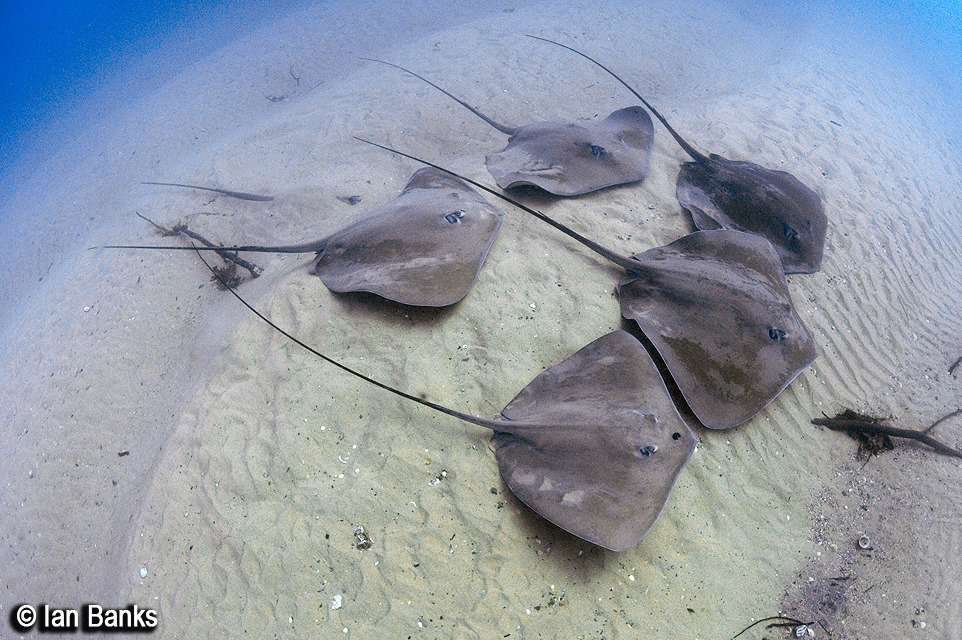Pink Whipray, Pateobatis fai Jordan & Seale 1906

Pink Whiprays, Pateobatis fai, on the Gold Coast Seaway, southern Queensland, May 2017. Source: Ian Banks / iNaturalist.org. License: CC by Attribution-NonCommercial
Summary:
A large diamond-shaped greyish to brownish-pink stingray with a uniformly pale underside, and an extremely long narrow tail bearing a single serrated venomous spine.
Although the Pink Whipray is not considered dangerous, the venomous spine on the tail may cause a painful wound.
This species was previously known as Himantura fai.
Although the Pink Whipray is not considered dangerous, the venomous spine on the tail may cause a painful wound.
This species was previously known as Himantura fai.
Cite this page as:
Bray, D.J. 2018, Pateobatis fai in Fishes of Australia, accessed 02 Jul 2025, https://fishesofaustralia.net.au/home/species/3528
Pink Whipray, Pateobatis fai Jordan & Seale 1906
More Info
|
Distribution |
Known in Australia from from Ningaloo Reef, Western Australia, to the Gold Coast, Queensland. Elsewhere, the species is widespread in the tropical Indo-west-central-Pacific. Small to large groups of Pink Whiprays are often seen resting on sand flats and sandy areas near reefs throughout their range. |
|
Features |
Disc diamond-shaped, tail extremely long and narrow with a single serrated venomous spine, small rounded denticles covering the body, and a series of small, sharp thorns along the midline. |
|
Size |
Grows to a total length (TL) of more than 500 cm, and a disc width (DW) of at least 184 cm. |
|
Colour |
Uniform greyish to brownish-pink above, with a uniformly pale underside and the tail dark greyish to black beyond the spine. |
|
Feeding |
Carnivore - feeds mostly on decapod crustaceans, and on cephalopods and bony fishes. |
|
Biology |
Reproductive mode - aplacental viviparous (ovoviviparous). Embryos initially feed on yolk, before absorbing a special uterine fluid produced by the mother. Size at birth ~ 55 cm DW. |
|
Fisheries |
In northern Australia, the Pink Whipray is taken as incidental bycatch in the Northern Prawn Fishery (NPF), although catches have decreased with the introduction of Turtle Exclusion Devices (TEDs) and Bycatch Reduction Devices (BRDs). |
|
Remarks |
Large individuals writhing on a trawl deck may be dangerous due to the venomous spine on the tail. |
|
Similar Species |
May be confused with Jenkin's Whipray, Himantura jenkinsii, which is yellowish-brown, and has closely-spaced denticles on in the centre of the disc, plus rows of enlarged thorn-like denticles along the disc midline to the just before the spine on the tail. |
|
Species Citation |
Himantura fai Jordan & Seale, 1906, Bull. Bur. Fish. (U.S.) 1905 25: 184, fig. 2. Type locality: Apia, Upolu Island, Western Samoa. |
|
Author |
Bray, D.J. 2018 |
|
Resources |
Pink Whipray, Pateobatis fai Jordan & Seale 1906
References
Coleman, N. 1981. Australian Sea Fishes North of 30°S. Doubleday Australia Pty. Ltd, New South Wales. (as Himantura fai)
Dulvy, N.K.& Reynolds, J.D. 1997. Evolutionary transitions among egg-laying, live-bearing and maternal inputs in sharks and rays. Proc. R. Soc. Lond., Ser. B: Biol. Sci. 264: 1309-1315. (as Himantura fai)
Johnson, J. W. 1999 [ref. 25471] See ref. at BHL Annotated checklist of the fishes of Moreton Bay, Queensland, Australia. Memoirs of the Queensland Museum 43(2): 709-762. Ref at BHL
Johnson, J.W. 2010. Fishes of the Moreton Bay Marine Park and adjacent continental shelf waters, Queensland, Australia. pp. 299-353 in Davie, P.J.F. & Phillips, J.A. Proceedings of the Thirteenth International Marine Biological Workshop, The Marine Fauna and Flora of Moreton Bay. Memoirs of the Queensland Museum 54(3) (as Himantura fai)
Jordan, D.S. & Seale, A. 1906. The fishes of Samoa. Description of the species found in the Archipelago, with a provisional checklist of the fishes of Oceania. Bulletin of the Bureau of Fisheries (U.S.) for 1905 25: 173-455 figs 1-111 pls 33-53 (as Himantura fai) Ref at BHL
Kitchener, P.D. & Snow, P.J. 2010. Spinal reflexes in the long-tailed stingray, Himantura fai. J Comp Physiol A Neuroethol Sens Neural Behav Physiol. 196(4): 263-70. doi: 10.1007/s00359-010-0512-x. Epub 2010 Mar 6. (as Himantura fai) Abstract
Larson, H.K., Williams, R.S. & Hammer, M.P. 2013. An annotated checklist of the fishes of the Northern Territory, Australia. Zootaxa 3696(1): 1-293 (as Himantura fai)
Last, P.R. & Compagno, L.J.V. 1999. Family Dasyatidae. pp. 1479-1505 in Carpenter, K.E. & Niem, V.H. (eds). The Living Marine Resources of the Western Central Pacific. FAO Species Identification Guide for Fisheries Purposes. Rome : FAO Vol. 3 pp. 1397-2068. (as Himantura fai)
Last, P.R., Manjaji-Matsumoto, B.M., Naylor, G.J.P. & White, W.T. (2016) Family Dasyatidae pp. 522-618. In: Last, P.R., White, W.T., de Carvalho, M.R., Séret, B., Stehmann, M.F.W. & & Naylor, G.J.P. (eds) Rays of the World. Melbourne: CSIRO Publishing, 800 pp.
Last, P.R., Naylor, G.J.P. & Manjaji-Matsumoto, B.M. 2016. A revised classification of the family Dasyatidae (Chondrichthyes: Myliobatiformes) based on new morphological and molecular insights. Zootaxa 4139(3): 345–368. DOI: http://dx.doi.org/10.11646/zootaxa.4139.3.2 Abstract
Last, P.R. & Stevens, J.D. 1994. Sharks and Rays of Australia. Canberra : CSIRO Australia 513 pp. 84 pls. (as Himantura fai)
Last, P.R. & Stevens, J.D. 2009. Sharks and Rays of Australia. Collingwood : CSIRO Publishing Australia 2, 550 pp. (as Himantura fai)
Manjaji, B.M. 2004. Taxonomy and phylogenetic systematic of the stingray genus Himantura (Family Dasyatidae). PhD Dissertation, University of Tasmania. (as Himantura fai)
Manjaji-Matsumoto, B.M. & Last, P.R. 2008. Himantura leoparda sp. nov., a new whipray (Myliobatoidei: Dasyatidae) from the Indo-Pacific. CSIRO Marine and Atmospheric Research Paper No. 022: 292-301.
White, W.T., Last, P.R., Stevens, J.D., Yearsley, G.K., Fahmi & Dharmadi. 2006. Economically Important Sharks and Rays of Indonesia. Australian Centre for International Agricultural Research, Canberra, Australia. (as Himantura fai)





